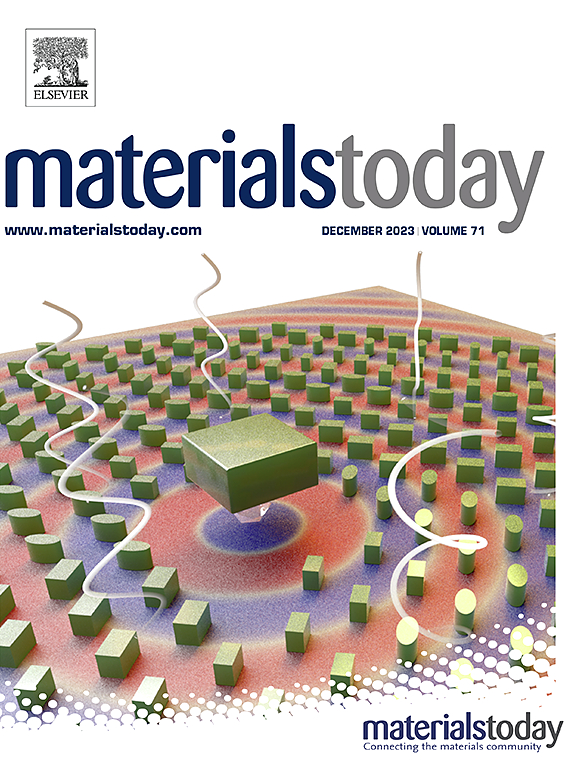一种用于无枝晶固态锂金属电池的具有Li+导电/e−绝缘性能的刚柔凝胶夹层
IF 21.1
1区 材料科学
Q1 MATERIALS SCIENCE, MULTIDISCIPLINARY
引用次数: 0
摘要
固态锂金属电池(sslmb)因其高能量密度而备受关注。然而,这些电池的发展受到锂枝晶生长问题的阻碍,引发了安全问题。本研究通过一种简单、经济、可扩展的原位热聚合方法,在石榴石型Li6.4La3Zr1.4Ta0.6O12 (LLZTO)和Li金属之间引入有机-无机凝胶夹层(GI),解决了这一问题。GI具有三维交联网络和LLZTO颗粒的特征,增强了界面离子接触,促进了Li+在界面的迁移和扩散。GI的电子绝缘特性阻止了Li枝晶向固态电解质的生长,并适应了在电镀和剥离过程中Li体积的变化。此外,电化学循环形成富liff界面,促进均匀的Li沉积。因此,锂对称电池表现出1.9 mA cm - 2的高临界电流密度和1.5 mA cm - 2下600小时的延长循环寿命。当sslmb与LiFePO4、LiNi0.5Co0.2Mn0.3O2和氟化碳(CF)阴极耦合时,表现出优异的电化学性能。在这项工作中获得的对界面特性的见解和演示的简单策略有可能加速sslmb人工中间层的发展,最终导致具有优越电化学性能的电池。本文章由计算机程序翻译,如有差异,请以英文原文为准。

A rigid-flexible gel interlayer with Li+-conducting/e−-insulating properties for dendrite-free solid-state lithium metal batteries
Solid-state lithium metal batteries (SSLMBs) have garnered significant attention due to their high energy density. However, the development of these batteries is hindered by the problematic growth of lithium dendrites, posing safety concerns. This study addresses this issue by introducing an organic–inorganic gel interlayer (GI) between garnet-type Li6.4La3Zr1.4Ta0.6O12 (LLZTO) and Li metal using a simple, cost-effective, and scalable in-situ thermal polymerization method. The GI features a three-dimensional cross-linked network and LLZTO particles, enhancing interfacial ionic contact and facilitating Li+ migration and diffusion at the interface. The electron-insulating nature of the GI prevents the growth of Li dendrites toward solid-state electrolytes and accommodates changes in Li volume during the plating and stripping process. Additionally, the electrochemical cycling forms a LiF-rich interphase, promoting uniform Li deposition. Consequently, Li symmetric cells exhibit a high critical current density of 1.9 mA cm−2 and an extended cycling life of 600 h at 1.5 mA cm−2. SSLMBs, when coupled with LiFePO4, LiNi0.5Co0.2Mn0.3O2, and carbon fluoride (CF) cathodes, showcase outstanding electrochemical performance. The insights gained into interface properties and the demonstrated facile strategy in this work have the potential to accelerate the development of artificial interlayers for SSLMBs, ultimately leading to batteries with superior electrochemical performance.
求助全文
通过发布文献求助,成功后即可免费获取论文全文。
去求助
来源期刊

Materials Today
工程技术-材料科学:综合
CiteScore
36.30
自引率
1.20%
发文量
237
审稿时长
23 days
期刊介绍:
Materials Today is the leading journal in the Materials Today family, focusing on the latest and most impactful work in the materials science community. With a reputation for excellence in news and reviews, the journal has now expanded its coverage to include original research and aims to be at the forefront of the field.
We welcome comprehensive articles, short communications, and review articles from established leaders in the rapidly evolving fields of materials science and related disciplines. We strive to provide authors with rigorous peer review, fast publication, and maximum exposure for their work. While we only accept the most significant manuscripts, our speedy evaluation process ensures that there are no unnecessary publication delays.
 求助内容:
求助内容: 应助结果提醒方式:
应助结果提醒方式:


